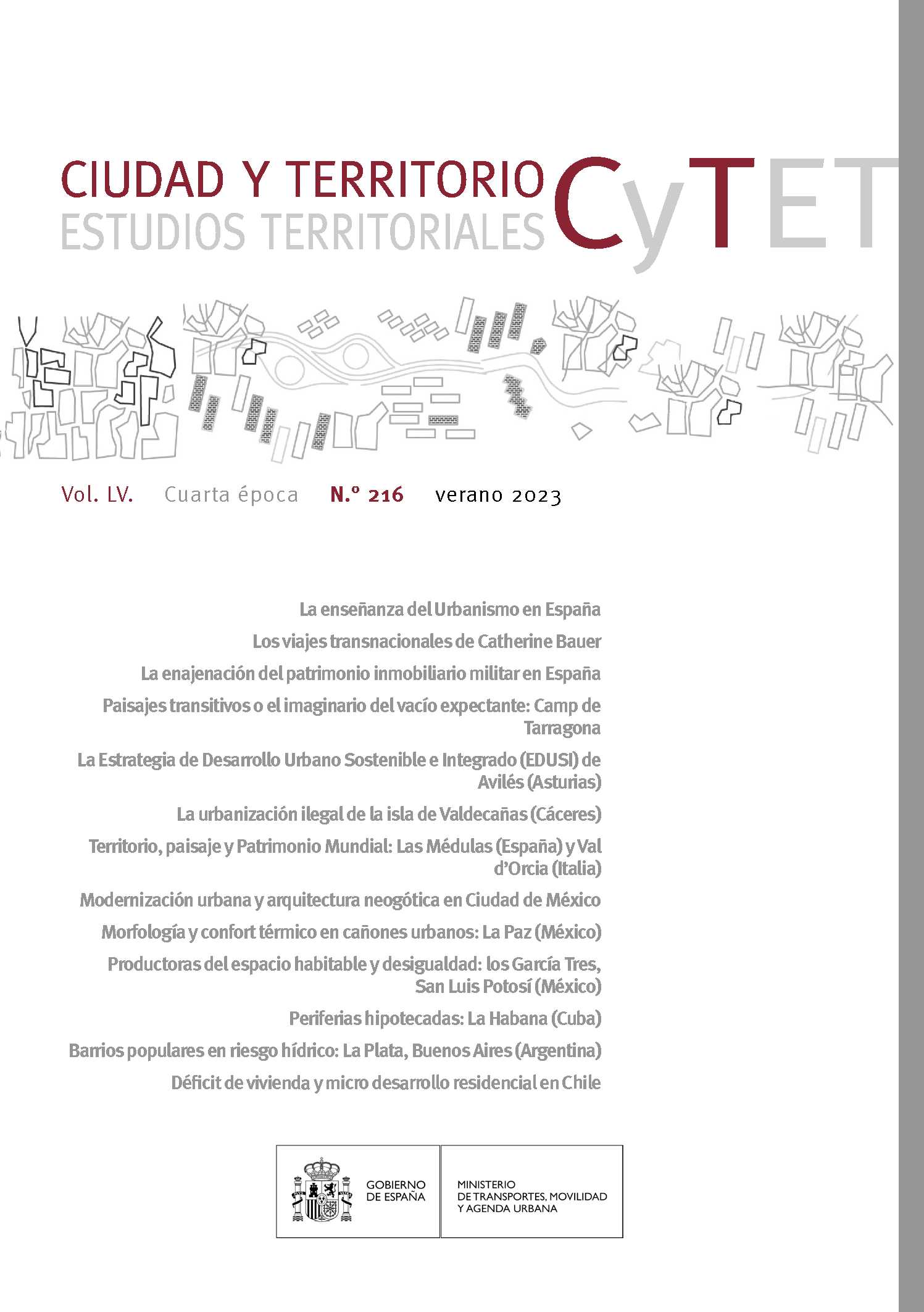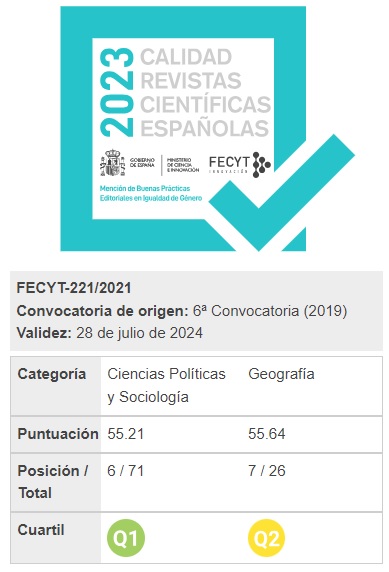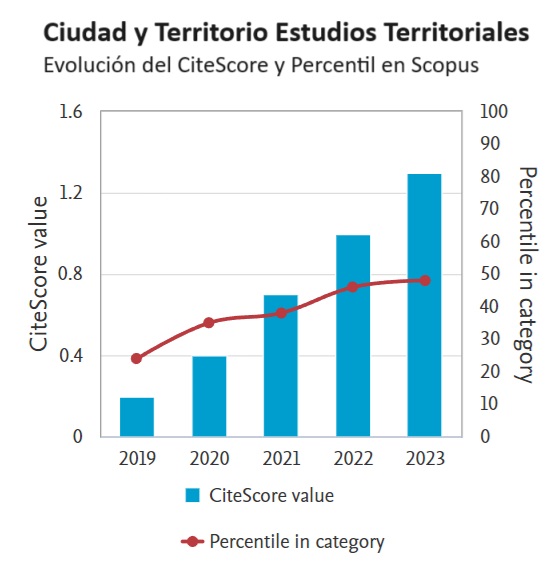Simulation of different urban canyons configurations to determine outdoor thermal comfort in an arid city (La Paz) of México
DOI:
https://doi.org/10.37230/CyTET.2023.216.9Keywords:
Urban canyon, Local Climate Zone, Sky View Factor, Physiological Equivalent TemperatureAbstract
In recent years, urban microclimate research on urbanization and land use distribution has predominated. Consequently, research has focused on understanding the microclimate impacts of urban structures, materials, and vegetation. The present study aims to analyze the effects of urban canyons morphology (aspect ratio, orientation, and vegetation) and their impact on thermal comfort. Four urban canyons were evaluated, and the results indicate that each canyon's orientation and spatial configuration influence the climatic parameters associated with the PET(Phisiologycal Equivalent Temperature) index. The information obtained will make it possible to establish actions from urban and territorial planning to generate energy consumption solutions and improve the inhabitants' health by avoiding thermal and heat stress.
Downloads
References
Abd Elraouf, R. & Elmokadem, A. & Megahed, N. & Abo Eleinen, O. & Eltarabily, S. (2022): The impact of urban geometry on outdoor thermal comfort in a hot-humid climate. Building and Environment, 225(September), 109632. https://doi.org/10.1016/j.buildenv.2022.109632
Acero, J. A. & Koh, E. J. Y. & Ruefenacht, L. A. & Norford, L. K. (2021): Modelling the influence of high-rise urban geometry on outdoor thermal comfort in Singapore. Urban Climate, 36(November 2020), 100775. https://doi.org/10.1016/j.uclim.2021.100775
Aflaki, A. & Mirnezhad, M. & Ghaffarianhoseini, A. & Ghaffarianhoseini, A. & Omrany, H. & Wang, Z. H. & Akbari, H. (2017): Urban heat island mitigation strategies: A state-of-the-art review on Kuala Lumpur, Singapore and Hong Kong. Cities, 62, 131–145. https://doi.org/10.1016/j.cities.2016.09.003
Ahmad, K. & Khare, M. & Chaudhry, K. K. (2005): Wind tunnel simulation studies on dispersion at urban street canyons and intersections - A review. Journal of Wind Engineering and Industrial Aerodynamics, 93(9), 697–717. https://doi.org/10.1016/j.jweia.2005.04.002
Ahmadi Venhari, A. & Tenpierik, M. & Taleghani, M. (2019): The role of sky view factor and urban street greenery in human thermal comfort and heat stress in a desert climate. Journal of Arid Environments, 166(July 2018), 68–76. https://doi.org/10.1016/j.jaridenv.2019.04.009
Ali-Toudert, F. & Mayer, H. (2007): Erratum to “Numerical study on the effects of aspect ratio and orientation of an urban street canyon on outdoor thermal comfort in hot and dry climate” [Building and Environment 41 (2006) 94-108] (DOI:10.1016/j.buildenv.2005.01.013). Building and Environment, 42(3), 1553–1554. https://doi.org/10.1016/j.buildenv.2005.12.013
Ali, M. H. & Abustan, I. (2014): A new novel index for evaluating model performance. Journal of Natural Resources and Development, 2002, 1–9. https://doi.org/10.5027/jnrd.v4i0.01
Allende, F. & Fernández García, F. & Rasilla Álvarez, D. & Alcaide Muñoz, J. (2018). Isla de calor nocturna estival y confort térmico en Madrid: avance para un planeamiento térmico en áreas urbanas. L(195), 101–120.
Bhaskar, D. E. & Mukherjee, M. (2017): Optimizing street canyon orientation for Rajarhat Newtown, Kolkata, India. Environmental and Climate Technologies, 21(1), 5–17. https://doi.org/10.1515/rtuect-2017-0012
Bruse, M. (1999): Die Auswirkungen kleinskaliger Umweltgestaltung auf das Mikroklima. 192.
Chatzidimitriou, A. & Yannas, S. (2017): Street canyon design and improvement potential for urban open spaces; the influence of canyon aspect ratio and orientation on microclimate and outdoor comfort. Sustainable Cities and Society, 33(February), 85–101. https://doi.org/10.1016/j.scs.2017.05.019
Chinese University of Hong Kong, CUHK (2012): Urban climatic map and standards for wind environment feasibility study final report. In Hong Kong Planning Department. (Issue November). https://doi.org/10.13140/RG.2.1.5165.0000
Deng, J. Y. & Wong, N. H. (2020): Impact of urban canyon geometries on outdoor thermal comfort in central business districts. Sustainable Cities and Society, 53(November 2019), 101966. https://doi.org/10.1016/j.scs.2019.101966
Dissanayake, C. & Weerasinghe, U. G. D. & Dharmasena, J. (2021): Assessment of Thermal Comfort and Microclimate in Urban Street Canyons – A Review of Recent Research. The IAFOR International Conference on Sustainability, Energy & the Environment – Hawaii 2021 Official Conference Proceedings, 77–95. https://doi.org/10.22492/issn.2432-8642.2021.6
Dzyuban, Y. & Ching, G. N. Y. & Yik, S. K. & Tan, A. J. & Banerjee, S. & Crank, P. J. & Chow, W. T. L. (2022): Outdoor thermal comfort research in transient conditions: A narrative literature review. Landscape and Urban Planning, 226(May), 104496. https://doi.org/10.1016/j.landurbplan.2022.104496
García, E. (2004): Modificaciones al sistema de clasificación climática de Köppen. In Instituto de Geografía Universidad Nacional Autónoma de México. https://doi.org/10.2307/j.ctv1xxv3n.2
Golasi, I., Salata, F., De Lieto Vollaro, E., & Coppi, M. (2018): Complying with the demand of standardization in outdoor thermal comfort: a first approach to the Global Outdoor Comfort Index (GOCI). In Building and Environment (Vol. 130). Elsevier Ltd. https://doi.org/10.1016/j.buildenv.2017.12.021
Hoppe, P. (1999): The physiological equivalent temperature - a universal index for the biometeorological assessment of the thermal environment. International Journal of Biometeorology, 43(2), 71–75.
Hu, C. B. & Zhang, F. & Gong, F. Y. & Ratti, C. & Li, X. (2020): Classification and mapping of urban canyon geometry using Google Street View images and deep multitask learning. Building and Environment, 167(May 2019), 106424. https://doi.org/10.1016/j.buildenv.2019.106424
Jamei, E. & Rajagopalan, P. (2017): Urban development and pedestrian thermal comfort in Melbourne. Solar Energy, 144, 681–698. https://doi.org/10.1016/j.solener.2017.01.023
Jamei, E. (2019): Effect of street design on pedestrian thermal comfort. Architectural Science Review, 62(2), 92–111. https://doi.org/10.1080/00038628.2018.1537236
Limona, S. S. & Al-Hagla, K. S. & El-Sayad, Z. T. (2019): Using simulation methods to investigate the impact of urban form on human comfort. Case study: Coast of Baltim, North Coast, Egypt. Alexandria Engineering Journal, 58(1), 273–282. https://doi.org/10.1016/j.aej.2019.02.002
Lizárraga. (2013): La configuración urbana de la ciudad de La Paz Baja California Sur desde la perspectiva de género. In UABCS (Issue 9).
Lobaccaro, G. & Acero, J. A. & Martinez, G. S. & Padro, A. & Laburu, T. & Fernandez, G. (2019): Effects of orientations, aspect ratios, pavement materials and vegetation elements on thermal stress inside typical urban canyons. International Journal of Environmental Research and Public Health, 16(19). https://doi.org/10.3390/ijerph16193574
Mahmoud H. & Ghanem H. (2019): Urban Geometry Mitigation Guidelines To Improve Outdoor Thermal Performance. Journal of Engineering Sciences Assiut University Faculty of Engineering, 47, 172–193.
Makaremi, N. & Salleh, E. & Jaafar, M. Z. & Ghaffarianhoseini, A. H. (2012): Thermal comfort conditions of shaded outdoor spaces in hot and humid climate of Malaysia. Building and Environment, 48(1), 7–14. https://doi.org/10.1016/j.buildenv.2011.07.024
Matzarakis, A. (2018). RayMan Pro.
Matzarakis, A. & Rutz, F. & Mayer, H. (2007): Modelling radiation fluxes in simple and complex environments - Application of the RayMan model. International Journal of Biometeorology, 51(4), 323–334. https://doi.org/10.1007/s00484-006-0061-8
Matzarakis, A. & Rocco, M. & Najjar, G. (2009): Thermal bioclimate in Strasbourg - The 2003 heat wave. Theoretical and Applied Climatology, 98(3–4), 209–220. https://doi.org/10.1007/s00704-009-0102-4
Matzarakis, A. & Rutz, F., & Mayer, H. (2010): Modelling radiation fluxes in simple and complex environments: Basics of the RayMan model. International Journal of Biometeorology, 54(2), 131–139. https://doi.org/10.1007/s00484-009-0261-0
Middel A. & Lukasczyk, J., & Maciejewski, R. (2017): Sky view factors from synthetic fisheye photos for thermal comfort outing—A case study in Phoenix, Arizona. Urban Planning, 2(1), 19–30. https://doi.org/10.17645/up.v2i1.855
Mohajerani, A., Jason, B., & Jeffrey-Bailey, T. (2017): The urban heat island effect, its causes, and mitigation, with reference to the thermal properties of asphalt concrete. Journal of Environmental Management, 197, 522–538. https://doi.org/10.1016/j.jenvman.2017.03.095
Molenaar, R. E. & Heusinkveld, B. G. & Steeneveld, G. J. (2016): Projection of rural and urban human thermal comfort in The Netherlands for 2050. International Journal of Climatology, 36(4), 1708–1723. https://doi.org/10.1002/joc.4453
Morakinyo, T. E., & Lam, Y. F. (2016): Simulation study on the impact of tree-configuration, planting pattern and wind condition on street-canyon’s micro-climate and thermal comfort. Building and Environment, 103, 262–275. https://doi.org/10.1016/j.buildenv.2016.04.025
Muniz-Gäal, L. P. & Pezzuto, C. C. & Carvalho, M. F. H. De & Mota, L. T. M. (2020): Urban geometry and the microclimate of street canyons in tropical climate. Building and Environment, 169(November 2019). https://doi.org/10.1016/j.buildenv.2019.106547
Ng, E. & Yau, R. & Wong, Ks. Ren, C. & Katszchener, L. (2012): Urban Climatic Map and Standards for Wind Environment Feasibility Study Final Report. Hong Kong Planning Department., November, 518. https://doi.org/10.13140/RG.2.1.5165.0000
Oke, T. R. (1981): Canyon Geometry and the Urban Heat Island. Journal of Climatology, 1, 237–254.
Oke, T. R. (1988): Street design and urban canopy layer climate. Energy and Buildings, 11(1–3), 103–113. https://doi.org/10.1016/0378-7788(88)90026-6
Oke, T. R. (2004): Initial Guidance To Obtain Representative. In Wmo Iom (Issue 81).
Potchter, O. & Cohen, P. & Lin, T. P. & Matzarakis, A. (2018): Outdoor human thermal perception in various climates: A comprehensive review of approaches, methods and quantification. Science of the Total Environment, 631–632, 390–406. https://doi.org/10.1016/j.scitotenv.2018.02.276
Qaid, A. & Lamit, H. Bin & Ossen, D. R. & Rasidi, M. H. (2018): Effect of the position of the visible sky in determining the sky view factor on micrometeorological and human thermal comfort conditions in urban street canyons. Theoretical and Applied Climatology, 131(3–4), 1083–1100. https://doi.org/10.1007/s00704-016-2023-3
Ridha, S. J. (2018): Effect of Aspect Ratio and Symmetrical Distribution on Urban Design in Baghdad City, and the Impact of Greenery Strategies on improving Outdoor Thermal Comfort. IOP Conference Series: Earth and Environmental Science, 151(1). https://doi.org/10.1088/1755-1315/151/1/012035
Srivanit, M. & Jareemit, D. (2020): Modeling the influences of layouts of residential townhouses and tree-planting patterns on outdoor thermal comfort in Bangkok suburb. Journal of Building Engineering, 30(July 2019), 101262. https://doi.org/10.1016/j.jobe.2020.101262
Stewart, I. D. & Oke, T. R. (2012): Local climate zones for urban temperature studies. Bulletin of the American Meteorological Society, 93(12), 1879–1900. https://doi.org/10.1175/BAMS-D-11-00019.1
Tong, S. & Wong, N. H. & Tan, C. L. & Jusuf, S. K. & Ignatius, M., & Tan, E. (2017): Impact of urban morphology on microclimate and thermal comfort in northern China. Solar Energy, 155, 212–223. https://doi.org/10.1016/j.solener.2017.06.027
Published
How to Cite
Issue
Section
License
Copyright (c) 2023 Gladys Adriana Acosta Fernández

This work is licensed under a Creative Commons Attribution-NonCommercial-NoDerivatives 4.0 International License.
Considering the provisions of the current legislation on Intellectual Property, and in accordance with them, all authors publishing in CyTET give -in a non-exclusive way and without time limit- to the Ministry of Transport, Mobility and Urban Agenda the rights to disseminate, reproduce, communicate and distribute in any current or future format, on paper or electronic, the original or derived version of their work under a Creative Commons Attribution-NonCommercial-NoDerivative 4.0 license International (CC BY-NC-ND 4.0), as well as to include or assign to third parties the inclusion of its content in national and international indexes, repositories and databases, with reference and recognition in any case of its authorship.
In addition, when sending the work, the author(s) declares that it is an original work in which the sources that have been used are recognized, committing to respect the scientific evidence, to no longer modify the original data and to verify or refute its hypothesis. Author(s) also declare that the essential content of the work has not been previously published nor will it be published in any other publication while it is under evaluation by CyTET; and that it has not been simultaneously sent to another journal.
Authors must sign a Transfer of Rights Form, which will be sent to them from the CyTET Secretariat once the article is accepted for publication.
With the aim of promoting the dissemination of knowledge, CyTET joins the Open Journal Access (OA) movement and delivers all of its content to various national and international indexes, repositories and databases under this protocol; therefore, the submission of a work to be published in the journal presupposes the explicit acceptance by the author of this distribution method.
Authors are encouraged to reproduce and host their work published in CyTET in institutional repositories, web pages, etc. with the intention of contributing to the improvement of the transfer of knowledge and the citation of said works.







